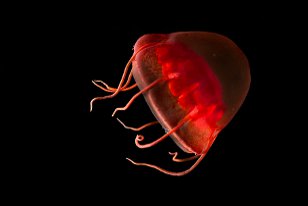Glow: Living Lights
PHILADELPHIA,
February 26, 2013

The beautiful undersea creature makes its own light.
A living organism’s ability to produce its own light is one of the most incredible, yet least understood, phenomena in nature. A new exhibit opening this spring at the Academy of Natural Sciences of Drexel University promises to illuminate this intriguing subject.
Glow: Living Lights, on display June 1–Sept. 29, takes visitors on a journey through land and sea in pursuit of fascinating creatures that light up the dark through a mysterious chemical process called bioluminescence. Fireflies, glow worms and alien-looking ocean creatures are just a few of the organisms that produce light for interesting reasons that scientists are still trying to understand.
The 2009 blockbuster movie Avatar helped bring the beauty of bioluminescence to the forefront. Scientists have known that about 90 percent of deep-sea creatures produce their own light, and today new applications of bioluminescence are being made in chemistry, genetics, ecology and medicine. In January a team of sea explorers made headlines when they were able to capture video of a rarely seen giant squid using lures that mimic a favorite food—bioluminescent jellyfish.
Visitors to Glow: Living Lights begin their journey in a darkened gallery filled with rare photographs, film footage of bioluminescent creatures, preserved specimens, and engaging activities. As visitors move along, they’ll come to understand that bioluminescence is a chemical process that differs from other forms of light.
Highlights include:
- live emperor scorpions and desert hairy scorpions that glow under ultraviolet light
- live swimming dinoflagellates (single-celled organisms) that light up at the touch of a button
- firefly and sea creature costumes that kids can don and pretend to be their favorite glowing animals
- details about how researchers are using natural light-producing abilities to detect harmful bacteria and even the presence of deadly anthrax spores
Around Philadelphia, bioluminescence can be seen each summer as various species of fireflies put on their shows in yards, ball fields and forest edges, said Academy Curator of Entomology Dr. Jon Gelhaus, who grew up in California where the firefly species do not glow. Gelhaus said he didn’t witness a firefly light show until he moved to Kansas at age 22 and later to South Jersey, where he totally enjoys “these wonderful fireflies with their greenish and yellowish flashes.”
Visitors to Glow: Living Lights will be able to observe live scorpions as they change color under ultraviolet light right before their eyes, though safely lodged in glass tanks. “Our visitors will get that sense of awe and excitement themselves,” said Gelhaus, who is also a professor in the Department of Biodiversity, Earth and Environmental Science at Drexel University.
Glow: Living Lights, produced by Exhibit IQ, is free with regular museum admission.
Media Contact